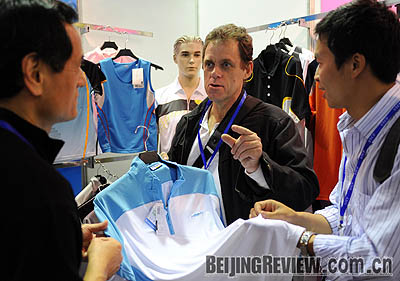|

HARD BARGAIN: Fast renminbi appreciation has haunted Chinese textile exporters, who are pressured by shrinking orders and lower prices
JIANG KEHONG
Pessimism has spread across the nation's textile and apparel exporting enterprises.
"At present, we don't compete over who make the biggest money, but on who can sustain their business the longest," said Xi Guoying, a textile manufacturer in Beijing. But even this slight dream of survival could be an extravagant hope. Xi said that if he does not get more orders, his company would have to give up exporting.
A dozen miles south of Tiananmen Square is a place called Dahongmen in south Beijing, known as the biggest textile distributing center in northern China. Each year, an international apparel festival is held here, where textile giants from Jiangsu, Zhejiang, Fujian and Guangdong provinces, as well as from Hong Kong, will gather to trade with international purchasers.
Xi, from Zhejiang, opened a garment factory here in the late 1990s, producing clothes and bed coverings, with a large proportion of those products exported to overseas markets through qualified exporting agents. In a few years, Xi's factory had an annual sales revenue of over 1 million yuan ($142,857) and provided over 30 jobs.
However, starting from last year, Xi began to feel the pinch in the export trade. Export agents he had good ties with over the years repeatedly cut the contract price. Xi said that three years ago he could get a 4-percent profit out of his exports. Now, the profit margin is only 0.1 percent. "I can only maintain this business from my past profits," said Xi.
Over a thousand textile production and distribution companies are working in the 6-square-km area of Dahongmen. Half of them are comparable in size to Xi's business. Yet, in the first four months this year, over a dozen of them turned away from foreign trade to concentrate on local distribution.
Downturn trend
In early March, the China National Textile and Apparel Council (CNTAC) investigated the situation in six provinces--Jiangsu, Shandong, Zhejiang, Guangdong, Fujian and Hebei--where the majority of textile manufacturers concentrate. The exporting volume of these six provinces accounts for 85 percent of the nation's total.
Sun Huaibin, Director of the China Textile Economy Research Center, was involved in the investigation in Shandong Province. Statistics provided by Sun show that in 2007 about 30 percent of exporting companies suffered losses, around 30 percent encountered profit slumps of over 30 percent, while 40 percent saw their profit margin drop 10-30 percent. To date, the profit decline continues.
Sun said that among the 40,000-plus textile enterprises in the province, one third created 80 percent of total profits in the industry, mostly with profit margins around 6-10 percent. Some 38.36 percent of these enterprises only had a 0.61-percent profit margin on average. Many of them suffered losses, with the total amount surpassing 9.9 billion yuan ($1.4 billion).
Watching their profit margins dwindle was the only choice for many. Shandong Sunvim Group Co. Ltd., the biggest home-use textile production company in Asia, has maintained its leading position in the industry for eight consecutive years in terms of export value. It hopes to earn a 5-percent profit this year, the same as that of last year. But a few years ago, Sunvim could count on an 8-10 percent return in profit.
Surprisingly, while the profit margin of textile companies dropped, their total export volume has kept increasing. Statistics from the National Bureau of Statistics showed that in the first quarter this year, the aggregate textile and apparel exports were valued at $37.44 billion, rising 19.44 percent from a year earlier.
| 